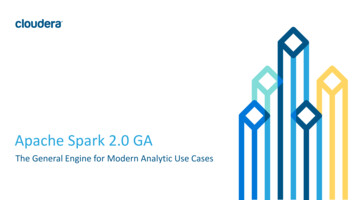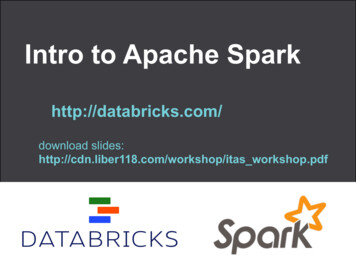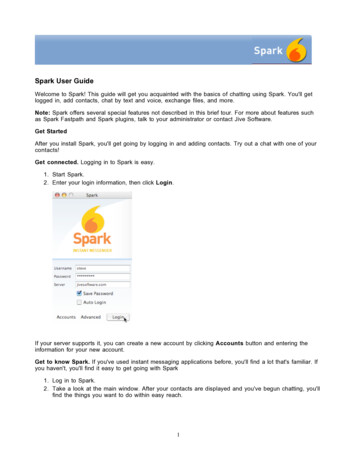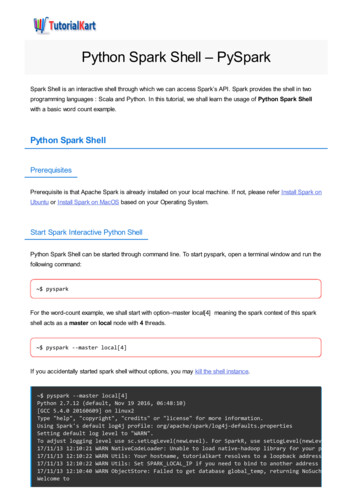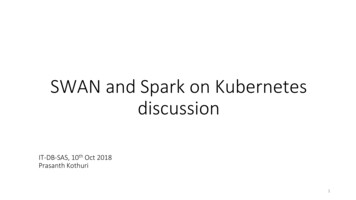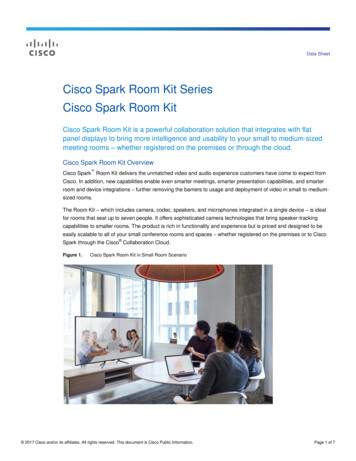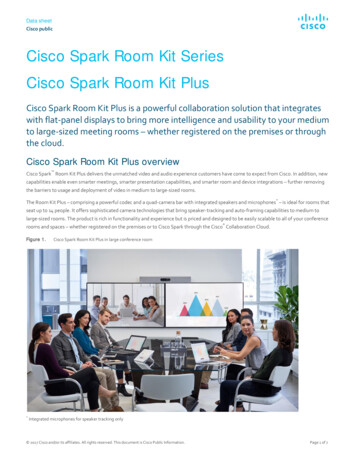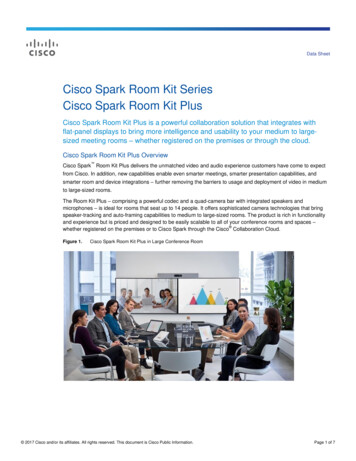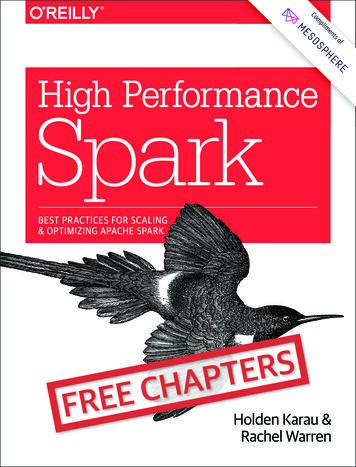
Transcription
ComplimentsofHigh PerformanceSparkBEST PRACTICES FOR SCALING& OPTIMIZING APACHE SPARKCEEFRSRETPAHHolden Karau &Rachel Warren
THE BEST PLACETO RUN SPARKWITH CONTAINERS.Mesosphere DC/OS makes it easy to build andelastically scale data-rich applications.1-Click Install & Operation of Data ServicesRun on Any Cloud, Public or PrivateSecure & Proven in ProductionDramatically Cuts Infrastructure CostsLEARN MORE
High Performance SparkBest Practices for Scaling andOptimizing Apache SparkThis Excerpt contains Chapters 1, 2, and Appendix A of thebook High Performance Spark. The complete book isavailable at oreilly.com and through other retailers.Holden Karau and Rachel WarrenBeijingBoston Farnham SebastopolTokyo
High Performance Sparkby Holden Karau and Rachel WarrenCopyright 2017 Holden Karau, Rachel Warren. All rights reserved.Printed in the United States of America.Published by O’Reilly Media, Inc., 1005 Gravenstein Highway North, Sebastopol, CA 95472.O’Reilly books may be purchased for educational, business, or sales promotional use. Online editions arealso available for most titles (http://oreilly.com/safari). For more information, contact our corporate/insti‐tutional sales department: 800-998-9938 or corporate@oreilly.com.Editor: Shannon CuttProduction Editor: Kristen BrownCopyeditor: Kim CoferProofreader: James FraleighIndexer: Ellen Troutman-ZaigInterior Designer: David FutatoCover Designer: Karen MontgomeryIllustrator: Rebecca DemarestFirst EditionJune 2017:Revision History for the First Edition2017-05-22:First ReleaseThe O’Reilly logo is a registered trademark of O’Reilly Media, Inc. High Performance Spark, the coverimage, and related trade dress are trademarks of O’Reilly Media, Inc.While the publisher and the authors have used good faith efforts to ensure that the information andinstructions contained in this work are accurate, the publisher and the authors disclaim all responsibilityfor errors or omissions, including without limitation responsibility for damages resulting from the use ofor reliance on this work. Use of the information and instructions contained in this work is at your ownrisk. If any code samples or other technology this work contains or describes is subject to open sourcelicenses or the intellectual property rights of others, it is your responsibility to ensure that your usethereof complies with such licenses and/or rights.978-1-491-94320-5[LSI]
Table of ContentsForeword. . . . . . . . . . . . . . . . . . . . . . . . . . . . . . . . . . . . . . . . . . . . . . . . . . . . . . . . . . . . . . . . . . . . . vii1. Introduction to High Performance Spark. . . . . . . . . . . . . . . . . . . . . . . . . . . . . . . . . . . . . . . . 1What Is Spark and Why Performance MattersWhat You Can Expect to Get from This BookSpark VersionsWhy Scala?To Be a Spark Expert You Have to Learn a Little Scala AnywayThe Spark Scala API Is Easier to Use Than the Java APIScala Is More Performant Than PythonWhy Not Scala?Learning ScalaConclusion12333444562. How Spark Works. . . . . . . . . . . . . . . . . . . . . . . . . . . . . . . . . . . . . . . . . . . . . . . . . . . . . . . . . . . . 7How Spark Fits into the Big Data EcosystemSpark ComponentsSpark Model of Parallel Computing: RDDsLazy EvaluationIn-Memory Persistence and Memory ManagementImmutability and the RDD InterfaceTypes of RDDsFunctions on RDDs: Transformations Versus ActionsWide Versus Narrow DependenciesSpark Job SchedulingResource Allocation Across ApplicationsThe Spark ApplicationThe Anatomy of a Spark Job881011131416171719202022v
The DAGJobsStagesTasksConclusion2223232426A. Tuning, Debugging, and Other Things Developers Like to Pretend Don’t Exist. . . . . . . . 27vi Table of Contents
ForewordData is truly the new oil. The ability to easily access tremendous amounts of comput‐ing power has made data the new basis of competition. We’ve moved beyond tradi‐tional big data, where companies gained historical insights using batch analytics—intoday’s digital economy, businesses must learn to extract value from data and buildmodern applications that serve customers with personalized services, in real time,and at scale.At Mesosphere, we are seeing two major technology trends that enable modern appli‐cations to handle users and data at scale: containers and data services. Microservicebased applications that are deployed in containers speed time to market and reduceinfrastructure overhead, among other benefits. Data services capture, process, andstore data being used by the containerized microservices.A de facto architecture is emerging to build and operate fast data applications, with aset of leading technologies used within this architecture that are scalable, enable realtime processing, and open source. This set of technologies is often referred to as the“SMACK” stack:Apache KafkaA distributed, highly available messaging system to ensure millions of events persecond are captured through connected endpoints with no lossApache SparkA large-scale analytics engine that supports streaming, machine learning, SQL,and graph computationApache CassandraA distributed database that is highly available and scalableAkkaA toolkit and runtime to simplify development of data-driven appsForeword vii
Apache MesosA cluster resource manager that serves as a highly available, scalable, and effi‐cient platform for running data services and containerized microservices.High Performance Spark was written for data engineers and data scientists who arelooking to get the most out of Spark. The book lays out the key strategies to makeSpark queries faster, able to handle larger datasets, and use fewer resources.Mesosphere is proud to offer this excerpt, as we were founded with the goal of mak‐ing cutting edge technologies such as Spark and the SMACK stack easy to use. In fact,Spark was created as the first proof-of-concept workload to run on Mesos. Mesosserves as an elastic and proven foundation for building and elastically scaling datarich, modern applications. We created DC/OS to make Mesos simple to use, includ‐ing the automation of data services.We hope you enjoy the excerpt, and that you consider Mesosphere DC/OS to jumpstart your journey to building, deploying, and scaling a data-intensive applicationthat helps your business.— Tobi KnaupChief Technology Officer, Mesosphereviii Foreword
CHAPTER 1Introduction to High Performance SparkThis chapter provides an overview of what we hope you will be able to learn from thisbook and does its best to convince you to learn Scala. Feel free to skip ahead to Chap‐ter 2 if you already know what you’re looking for and use Scala (or have your heartset on another language).What Is Spark and Why Performance MattersApache Spark is a high-performance, general-purpose distributed computing systemthat has become the most active Apache open source project, with more than 1,000active contributors.1 Spark enables us to process large quantities of data, beyond whatcan fit on a single machine, with a high-level, relatively easy-to-use API. Spark’sdesign and interface are unique, and it is one of the fastest systems of its kind.Uniquely, Spark allows us to write the logic of data transformations and machinelearning algorithms in a way that is parallelizable, but relatively system agnostic. So itis often possible to write computations that are fast for distributed storage systems ofvarying kind and size.However, despite its many advantages and the excitement around Spark, the simplestimplementation of many common data science routines in Spark can be much slowerand much less robust than the best version. Since the computations we are concernedwith may involve data at a very large scale, the time and resources that gains fromtuning code for performance are enormous. Performance does not just mean runfaster; often at this scale it means getting something to run at all. It is possible to con‐struct a Spark query that fails on gigabytes of data but, when refactored and adjustedwith an eye toward the structure of the data and the requirements of the cluster,1 From http://spark.apache.org/.1
succeeds on the same system with terabytes of data. In the authors’ experience writ‐ing production Spark code, we have seen the same tasks, run on the same clusters,run 100 faster using some of the optimizations discussed in this book. In terms ofdata processing, time is money, and we hope this book pays for itself through areduction in data infrastructure costs and developer hours.Not all of these techniques are applicable to every use case. Especially because Sparkis highly configurable and is exposed at a higher level than other computationalframeworks of comparable power, we can reap tremendous benefits just by becomingmore attuned to the shape and structure of our data. Some techniques can work wellon certain data sizes or even certain key distributions, but not all. The simplest exam‐ple of this can be how for many problems, using groupByKey in Spark can very easilycause the dreaded out-of-memory exceptions, but for data with few duplicates thisoperation can be just as quick as the alternatives that we will present. Learning tounderstand your particular use case and system and how Spark will interact with it isa must to solve the most complex data science problems with Spark.What You Can Expect to Get from This BookOur hope is that this book will help you take your Spark queries and make themfaster, able to handle larger data sizes, and use fewer resources. This book covers abroad range of tools and scenarios. You will likely pick up some techniques thatmight not apply to the problems you are working with, but that might apply to aproblem in the future and may help shape your understanding of Spark more gener‐ally. The chapters in this book are written with enough context to allow the book tobe used as a reference; however, the structure of this book is intentional and readingthe sections in order should give you not only a few scattered tips, but a comprehen‐sive understanding of Apache Spark and how to make it sing.It’s equally important to point out what you will likely not get from this book. Thisbook is not intended to be an introduction to Spark or Scala; several other books andvideo series are available to get you started. The authors may be a little biased in thisregard, but we think Learning Spark by Karau, Konwinski, Wendell, and Zaharia aswell as Paco Nathan’s introduction video series are excellent options for Spark begin‐ners. While this book is focused on performance, it is not an operations book, so top‐ics like setting up a cluster and multitenancy are not covered. We are assuming thatyou already have a way to use Spark in your system, so we won’t provide much assis‐tance in making higher-level architecture decisions. There are future books in theworks, by other authors, on the topic of Spark operations that may be done by thetime you are reading this one. If operations are your show, or if there isn’t anyoneresponsible for operations in your organization, we hope those books can help you.2 Chapter 1: Introduction to High Performance Spark
Spark VersionsSpark follows semantic versioning with the standard [MAJOR].[MINOR].[MAINTE‐NANCE] with API stability for public nonexperimental nondeveloper APIs withinminor and maintenance releases. Many of these experimental components are someof the more exciting from a performance standpoint, including Datasets—SparkSQL’s new structured, strongly-typed, data abstraction. Spark also tries for binaryAPI compatibility between releases, using MiMa2; so if you are using the stable APIyou generally should not need to recompile to run a job against a new version ofSpark unless the major version has changed.This book was created using the Spark 2.0.1 APIs, but much of thecode will work in earlier versions of Spark as well. In places wherethis is not the case we have attempted to call that out.Why Scala?In this book, we will focus on Spark’s Scala API and assume a working knowledge ofScala. Part of this decision is simply in the interest of time and space; we trust readerswanting to use Spark in another language will be able to translate the concepts usedin this book without presenting the examples in Java and Python. More importantly,it is the belief of the authors that “serious” performant Spark development is mosteasily achieved in Scala.To be clear, these reasons are very specific to using Spark with Scala; there are manymore general arguments for (and against) Scala’s applications in other contexts.To Be a Spark Expert You Have to Learn a Little Scala AnywayAlthough Python and Java are more commonly used languages, learning Scala is aworthwhile investment for anyone interested in delving deep into Spark develop‐ment. Spark’s documentation can be uneven. However, the readability of the code‐base is world-class. Perhaps more than with other frameworks, the advantages ofcultivating a sophisticated understanding of the Spark codebase is integral to theadvanced Spark user. Because Spark is written in Scala, it will be difficult to interactwith the Spark source code without the ability, at least, to read Scala code. Further‐more, the methods in the Resilient Distributed Datasets (RDD) class closely mimicthose in the Scala collections API. RDD functions, such as map, filter, flatMap,2 MiMa is the Migration Manager for Scala and tries to catch binary incompatibilities between releases.Spark Versions 3
reduce, and fold, have nearly identical specifications to their Scala equivalents.3 Fun‐damentally Spark is a functional framework, relying heavily on concepts like immut‐ability and lambda definition, so using the Spark API may be more intuitive withsome knowledge of functional programming.The Spark Scala API Is Easier to Use Than the Java APIOnce you have learned Scala, you will quickly find that writing Spark in Scala is lesspainful than writing Spark in Java. First, writing Spark in Scala is significantly moreconcise than writing Spark in Java since Spark relies heavily on inline function defini‐tions and lambda expressions, which are much more naturally supported in Scala(especially before Java 8). Second, the Spark shell can be a powerful tool for debug‐ging and development, and is only available in languages with existing REPLs (Scala,Python, and R).Scala Is More Performant Than PythonIt can be attractive to write Spark in Python, since it is easy to learn, quick to write,interpreted, and includes a very rich set of data science toolkits. However, Spark codewritten in Python is often slower than equivalent code written in the JVM, since Scalais statically typed, and the cost of JVM communication (from Python to Scala) can bevery high. Last, Spark features are generally written in Scala first and then translatedinto Python, so to use cutting-edge Spark functionality, you will need to be in theJVM; Python support for MLlib and Spark Streaming are particularly behind.Why Not Scala?There are several good reasons to develop with Spark in other languages. One of themore important constant reasons is developer/team preference. Existing code, bothinternal and in libraries, can also be a strong reason to use a different language.Python is one of the most supported languages today. While writing Java code can beclunky and sometimes lag slightly in terms of API, there is very little performancecost to writing in another JVM language (at most some object conversions).43 Although, as we explore in this book, the performance implications and evaluation semantics are quitedifferent.4 Of course, in performance, every rule has its exception. mapPartitions in Spark 1.6 and earlier in Java sufferssome severe performance restrictions that we discuss in Chapter 5.4 Chapter 1: Introduction to High Performance Spark
While all of the examples in this book are presented in Scala for thefinal release, we will port many of the examples from Scala to Javaand Python where the differences in implementation could beimportant. These will be available (over time) at our GitHub. If youfind yourself wanting a specific example ported, please either emailus or create an issue on the GitHub repo.Spark SQL does much to minimize the performance difference when using a nonJVM language. Chapter 7 looks at options to work effectively in Spark with languagesoutside of the JVM, including Spark’s supported languages of Python and R. Thissection also offers guidance on how to use Fortran, C, and GPU-specific code to reapadditional performance improvements. Even if we are developing most of our Sparkapplication in Scala, we shouldn’t feel tied to doing everything in Scala, because spe‐cialized libraries in other languages can be well worth the overhead of going outsidethe JVM.Learning ScalaIf after all of this we’ve convinced you to use Scala, there are several excellent optionsfor learning Scala. Spark 1.6 is built against Scala 2.10 and cross-compiled againstScala 2.11, and Spark 2.0 is built against Scala 2.11 and possibly cross-compiledagainst Scala 2.10 and may add 2.12 in the future. Depending on how much we’veconvinced you to learn Scala, and what your resources are, there are a number of dif‐ferent options ranging from books to massive open online courses (MOOCs) to pro‐fessional training.For books, Programming Scala, 2nd Edition, by Dean Wampler and Alex Payne canbe great, although much of the actor system references are not relevant while workingin Spark. The Scala language website also maintains a list of Scala books.In addition to books focused on Spark, there are online courses for learning Scala.Functional Programming Principles in Scala, taught by Martin Ordersky, its creator, ison Coursera as well as Introduction to Functional Programming on edX. A numberof different companies also offer video-based Scala courses, none of which theauthors have personally experienced or recommend.For those who prefer a more interactive approach, professional training is offered bya number of different companies, including Lightbend (formerly Typesafe). While wehave not directly experienced Typesafe training, it receives positive reviews and isknown especially to help bring a team or group of individuals up to speed with Scalafor the purposes of working with Spark.Why Scala? 5
ConclusionAlthough you will likely be able to get the most out of Spark performance if you havean understanding of Scala, working in Spark does not require a knowledge of Scala.For those whose problems are better suited to other languages or tools, techniques forworking with other languages will be covered in Chapter 7. This book is aimed atindividuals who already have a grasp of the basics of Spark, and we thank you forchoosing High Performance Spark to deepen your knowledge of Spark. The nextchapter will introduce some of Spark’s general design and evaluation paradigms thatare important to understanding how to efficiently utilize Spark.6 Chapter 1: Introduction to High Performance Spark
CHAPTER 2How Spark WorksThis chapter introduces the overall design of Spark as well as its place in the big dataecosystem. Spark is often considered an alternative to Apache MapReduce, sinceSpark can also be used for distributed data processing with Hadoop.1 As we will dis‐cuss in this chapter, Spark’s design principles are quite different from those of Map‐Reduce. Unlike Hadoop MapReduce, Spark does not need to be run in tandem withApache Hadoop—although it often is. Spark has inherited parts of its API, design,and supported formats from other existing computational frameworks, particularlyDryadLINQ.2 However, Spark’s internals, especially how it handles failures, differfrom many traditional systems. Spark’s ability to leverage lazy evaluation withinmemory computations makes it particularly unique. Spark’s creators believe it to bethe first high-level programming language for fast, distributed data processing.3To get the most out of Spark, it is important to understand some of the principlesused to design Spark and, at a cursory level, how Spark programs are executed. In thischapter, we will provide a broad overview of Spark’s model of parallel computing anda thorough explanation of the Spark scheduler and execution engine. We will refer to1 MapReduce is a programmatic paradigm that defines programs in terms of map procedures that filter andsort data onto the nodes of a distributed system, and reduce procedures that aggregate the data on the mappernodes. Implementations of MapReduce have been written in many languages, but the term usually refers to apopular implementation called Hadoop MapReduce, packaged with the distributed filesystem, ApacheHadoop Distributed File System.2 DryadLINQ is a Microsoft research project that puts the .NET Language Integrated Query (LINQ) on top ofthe Dryad distributed execution engine. Like Spark, the DryadLINQ API defines an object representing a dis‐tributed dataset, and then exposes functions to transform data as methods defined on that dataset object.DryadLINQ is lazily evaluated and its scheduler is similar to Spark’s. However, DryadLINQ doesn’t use inmemory storage. For more information see the DryadLINQ documentation.3 See the original Spark Paper and other Spark papers.7
the concepts in this chapter throughout the text. Further, we hope this explanationwill provide you with a more precise understanding of some of the terms you’veheard tossed around by other Spark users and encounter in the Spark documenta‐tion.How Spark Fits into the Big Data EcosystemApache Spark is an open source framework that provides methods to process data inparallel that are generalizable; the same high-level Spark functions can be used to per‐form disparate data processing tasks on data of different sizes and structures. On itsown, Spark is not a data storage solution; it performs computations on Spark JVMs(Java Virtual Machines) that last only for the duration of a Spark application. Sparkcan be run locally on a single machine with a single JVM (called local mode). Moreoften, Spark is used in tandem with a distributed storage system (e.g., HDFS, Cassan‐dra, or S3) and a cluster manager—the storage system to house the data processedwith Spark, and the cluster manager to orchestrate the distribution of Spark applica‐tions across the cluster. Spark currently supports three kinds of cluster managers:Standalone Cluster Manager, Apache Mesos, and Hadoop YARN (see Figure 2-1).The Standalone Cluster Manager is included in Spark, but using the Standalone man‐ager requires installing Spark on each node of the cluster.Figure 2-1. A diagram of the data processing ecosystem including SparkSpark ComponentsSpark provides a high-level query language to process data. Spark Core, the maindata processing framework in the Spark ecosystem, has APIs in Scala, Java, Python,and R. Spark is built around a data abstraction called Resilient Distributed Datasets(RDDs). RDDs are a representation of lazily evaluated, statically typed, distributedcollections. RDDs have a number of predefined “coarse-grained” transformations(functions that are applied to the entire dataset), such as map, join, and reduce to8 Chapter 2: How Spark Works
manipulate the distributed datasets, as well as I/O functionality to read and write databetween the distributed storage system and the Spark JVMs.While Spark also supports R, at present the RDD interface is notavailable in that language. We will cover tips for using Java,Python, R, and other languages in detail in Chapter 7.In addition to Spark Core, the Spark ecosystem includes a number of other first-partycomponents, including Spark SQL, Spark MLlib, Spark ML, Spark Streaming, andGraphX,4 which provide more specific data processing functionality. Some of thesecomponents have the same generic performance considerations as the Core; MLlib,for example, is written almost entirely on the Spark API. However, some of themhave unique considerations. Spark SQL, for example, has a different query optimizerthan Spark Core.Spark SQL is a component that can be used in tandem with Spark Core and has APIsin Scala, Java, Python, and R, and basic SQL queries. Spark SQL defines an interfacefor a semi-structured data type, called DataFrames, and as of Spark 1.6, a semistructured, typed version of RDDs called called Datasets.5 Spark SQL is a veryimportant component for Spark performance, and much of what can be accom‐plished with Spark Core can be done by leveraging Spark SQL. We will cover SparkSQL in detail in Chapter 3 and compare the performance of joins in Spark SQL andSpark Core in Chapter 4.Spark has two machine learning packages: ML and MLlib. MLlib is a package ofmachine learning and statistics algorithms written with Spark. Spark ML is still in theearly stages, and has only existed since Spark 1.2. Spark ML provides a higher-levelAPI than MLlib with the goal of allowing users to more easily create practicalmachine learning pipelines. Spark MLlib is primarily built on top of RDDs and usesfunctions from Spark Core, while ML is built on top of Spark SQL DataFrames.6Eventually the Spark community plans to move over to ML and deprecate MLlib.Spark ML and MLlib both have additional performance considerations from SparkCore and Spark SQL—we cover some of these in Chapter 9.Spark Streaming uses the scheduling of the Spark Core for streaming analytics onminibatches of data. Spark Streaming has a number of unique considerations, such as4 GraphX is not actively developed at this point, and will likely be replaced with GraphFrames or similar.5 Datasets and DataFrames are unified in Spark 2.0. Datasets are DataFrames of “Row” objects that can beaccessed by field number.6 See the MLlib documentation.How Spark Fits into the Big Data Ecosystem 9
the window sizes used for batches. We offer some tips for using Spark Streaming inChapter 10.GraphX is a graph processing framework built on top of Spark with an API for graphcomputations. GraphX is one of the least mature components of Spark, so we don’tcover it in much detail. In future versions of Spark, typed graph functionality will beintroduced on top of the Dataset API. We will provide a cursory glance at GraphX inChapter 10.This book will focus on optimizing programs written with the Spark Core and SparkSQL. However, since MLlib and the other frameworks are written using the SparkAPI, this book will provide the tools you need to leverage those frameworks moreefficiently. Maybe by the time you’re done, you will be ready to start contributingyour own functions to MLlib and ML!In addition to these first-party components, the community has written a number oflibraries that provide additional functionality, such as for testing or parsing CSVs,and offer tools to connect it to different data sources. Many libraries are listed athttp://spark-packages.org/, and can be dynamically included at runtime with sparksubmit or the spark-shell and added as build dependencies to your maven or sbtproject. We first use Spark packages to add support for CSV data in Chapter 3 andthen in more detail in Chapter 10.Spark Model of Parallel Computing: RDDsSpark allows users to write a program for the driver (or master node) on a clustercomputing system that can perform operations on data in parallel. Spark representslarge datasets as RDDs—immutable, distributed collections of objects—which arestored in the executors (or slave nodes). The objects that comprise RDDs are calledpartitions and may be (but do not need to be) computed on different nodes of a dis‐tributed system. The Spark cluster manager handles starting and distributing theSpark executors across a distributed system according to the configuration parame‐ters set by the Spark application. The Spark execution engine itself distributes dataacross the executors for a computation. (See Figure 2-4.)Rather than evaluating each transformation as soon as specified by the driver pro‐gram, Spark evaluates RDDs lazily, computing RDD transformations only when thefinal RDD data needs to be computed (often by writing out to storage or collecting anaggregate to the driver). Spark can keep an RDD loaded in-memory on the executornodes throughout the life of a Spark application for faster access in repeated compu‐tations. As they are implemented in Spark, RDDs are immutable, so transforming anRDD returns a new RDD rather than the existing one. As we will explore in thischapter, this paradigm of lazy evaluation, in-memory storage, and immutabilityallows Spark to be easy-to-use, fault-tolerant, scalable, and efficient.10 Chapter 2: How Spark Works
Lazy EvaluationMany other systems for in-memory storage are based on “fine-grained” updates tomutable objects, i.e., calls to a particular cell in a table by storing intermediate results.In contrast, evaluation of RDDs is completely lazy. Spark does not begin computingthe partitions until an action is called. An action is a Spark operation that returnssomething other than an RDD, triggering evaluation of partitions and possiblyreturning some output to a non-Spark system (outside of the Spark executors); forexample, bringing data back to the driver (with operations like count or collect) orwriting data to an external storage storage system (such as copyToHadoop). Actionstrigger the scheduler, which builds a directed acyclic graph (called the DAG), basedon the dependencies between RDD transformations. In other words, Spark evaluatesan action by working backward to define the series of steps it has to take to produceeach object in the final distributed dataset (each partition). Then, using this series ofsteps, called the execution plan, the scheduler computes the missing partitions foreach stage until it computes the result.Not all transformations are 100% lazy. sortByKey needs to evaluatethe RDD to determine the range of data, so it involves both a trans‐formation and an action.Performance and usability advantages of lazy evaluationLazy evaluat
book and does its best to convince you to learn Scala. Feel free to skip ahead to Chap‐ ter 2 if you already know what you’re looking for and use Scala (or have your heart set on another language). What Is Spark and Why Performance Matters Apache Spark is a high-performan

